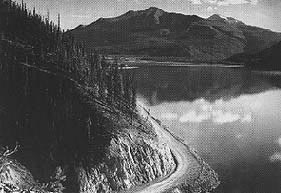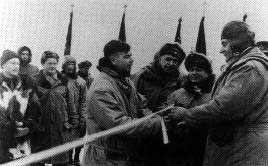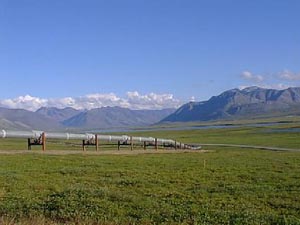 October 17, 2002
ARTBA, which celebrates its 100th Anniversary this year, conducted a national survey to help identify the top transportation infrastructure projects and public officials of the past century in all 50 states. The survey was sent to members of Congress, the nation's governors, state transportation department heads, newspaper editors, state and local chambers of commerce executives and college history professors. The Alaska Highway was recognized because of its importance to the nation's military mobilization in the 1940s and its continuing role as one of the state's major economic corridors. The dream of an overland route to Alaska began moving toward reality in 1933 when Congress authorized a U.S.-Canada commission to study the proposal. Spurred by the outbreak of World War II, construction started at Dawson Creek, British Columbia, early in 1942. Pushed through an untamed wilderness, the Alaska Highway was deemed a military necessity and stretches for over 1,500 miles to Fairbanks, Alaska. The highway was built in just 8 months at a cost of $140 million.
Conceived as an emergency wartime road, the highway has been continually improved and 90 percent of its length is now paved. It has evolved into an important link between the vast natural resources of Alaska and the Yukon and the industrial centers of the U.S. and Canada. The Trans-Alaska Pipeline System (TAPS) is an engineering marvel, a vital component of the Alaska economy and a major contributor to the energy supply of the United States. The pipeline runs 800 miles from the North Slope oilfields southward to Valdez, the nation's northernmost ice-free port. Some 420 miles of the pipeline are elevated above the ground, one of the many features designed to protect the fragile Alaskan environment. The 48-inch pipeline can transport 88,000 barrels of oil an hour. Construction of the Alaska pipeline was started in 1975, seven years after the discovery of oil at Prudhoe Bay in the North Slope. It was completed in 1977 at a cost of $8 billion. At
ARTBA also recognized Frank P. Moolin as the top Alaska public official. He was the senior engineer responsible for overseeing the design and construction of the Trans-Alaska Pipeline. Moolin helped manage a 28,000-man workforce that completed the project in 38 months. For 100 years, ARTBA has exclusively represented the U.S. transportation construction industry in the Nation's Capital. According to information provided by ARTBA, the association has played a key leadership role in the development and passage of every major piece of federal transportation legislation enacted by Congress over the past century. The transportation construction industry ARTBA represents generates $200 billion in U.S. economic activity annually and sustains the employment of 2.5 million Americans.
Source of News Release:
|
||||


